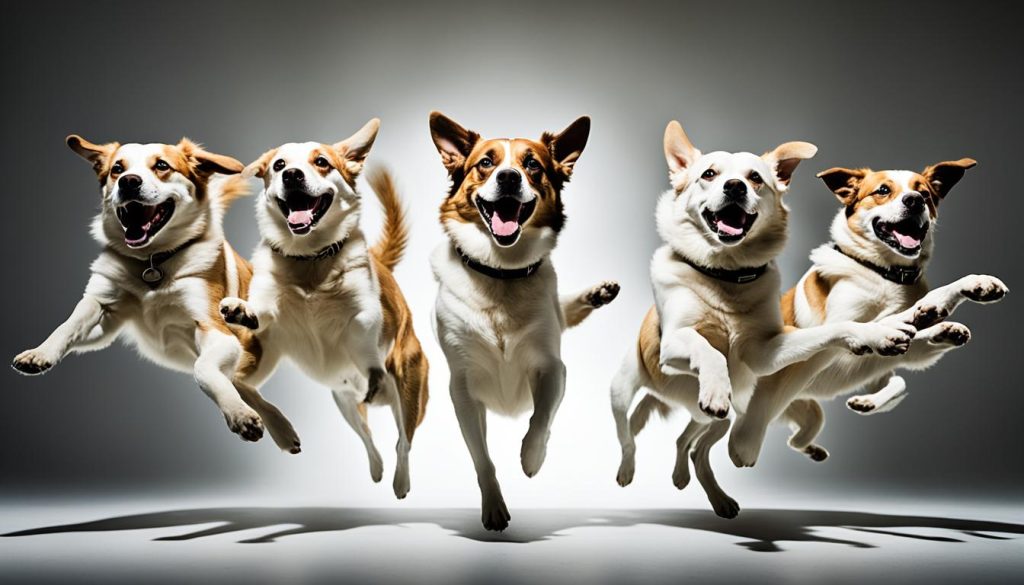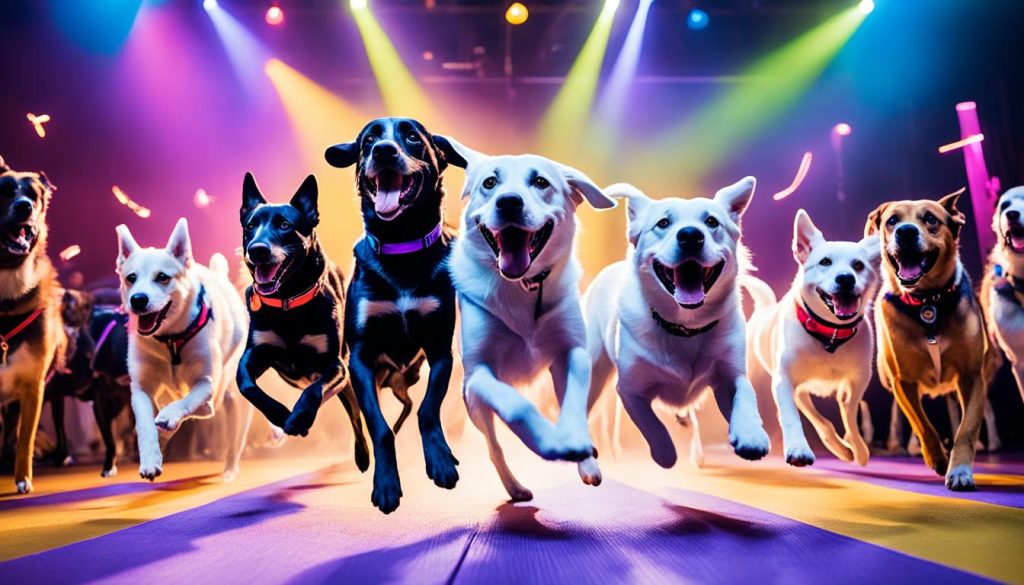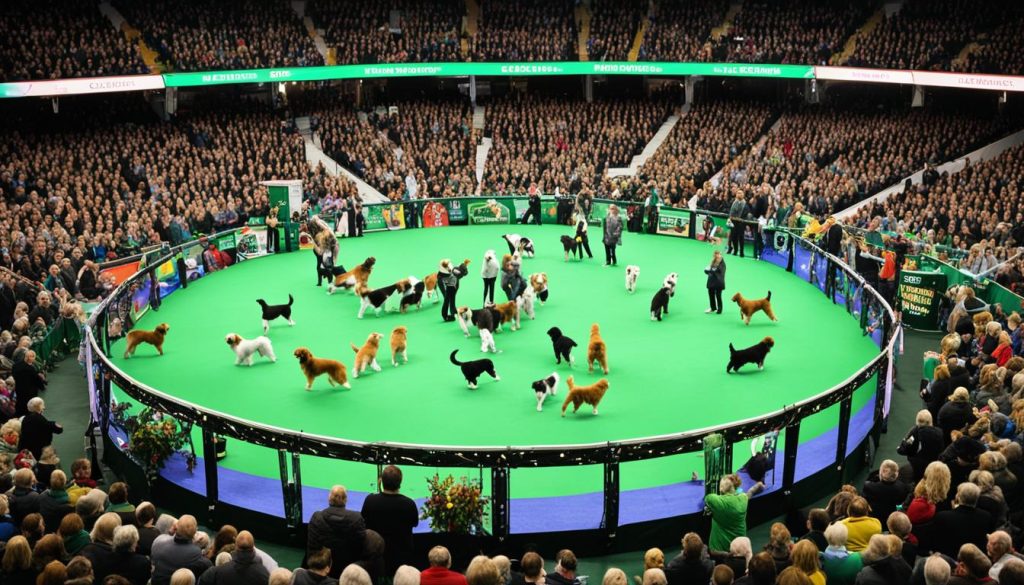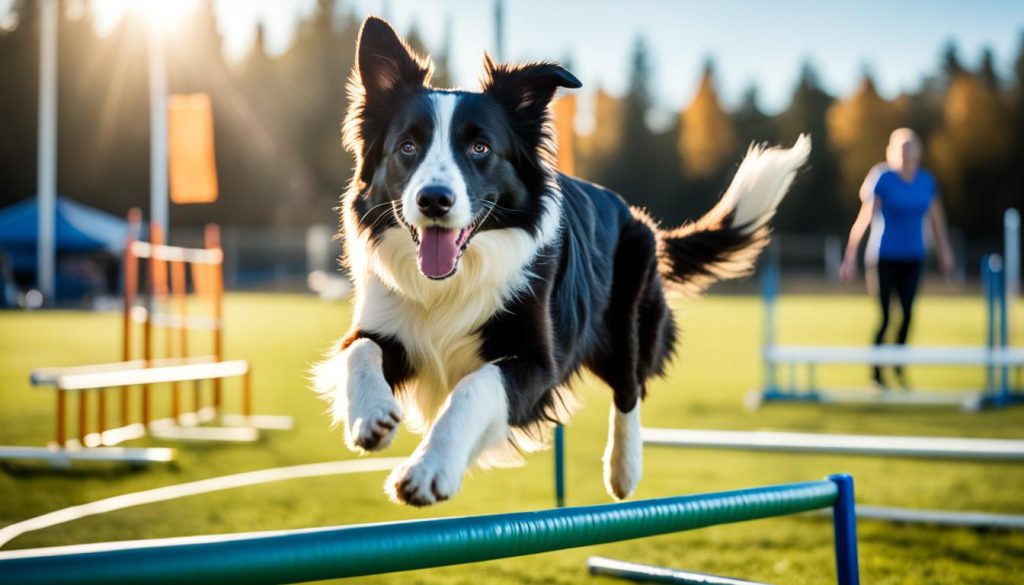A Border Collie stole the show on America’s Got Talent, getting four standing ovations and yes votes from the judges. This was thanks to the world of canine freestyle dancing, or dog dancing. It blends obedience training, trick skills, and dance moves to your favorite songs.
Imagine a routine so amazing that Simon Cowell called it better than past winners. Roni Sagi and her Border Collie, Rhythm, made their debut on Season 19 Episode 3 with a performance to “California Dreamin'”. Their routine got millions of views on TikTok and touched hearts all over the world.
Canine freestyle, Heelwork to Music, and Dances with Dogs show the strong bond between dogs and their owners. Roni started helping stray dogs as a kid, building trust and teamwork that shows in her acts today.
So, what makes dog dancing so captivating? Dr. Anna Foreman says dogs have a unique body structure that lets them move with grace. Rhythm’s skills make you think there might be a human inside that fur!
Let’s dive into canine freestyle dancing, its benefits, and top competitions. Learn how to teach your dog to dance. Discover the joy of moving together with your furry friend.
Quick Recommendation: Our blog is filled with tips and tricks for training your puppy or dog. If you are seeking a comprehensive training program, we recommend K9 Training Institute.
What is Canine Freestyle Dancing?
Canine Freestyle Dancing combines Dog Choreography and obedience training. It creates a fun and harmonious show of skill and agility. Handlers and their dogs perform routines to music, showing their bond, training, and creativity.
The Canine Freestyle Federation promotes this art through classes and training in places like Tennessee, the Mid-Atlantic, Minnesota, North Carolina, Ohio, and Sarasota, Florida. These groups focus on respect, teamwork, and creativity. They let the dog’s natural movement shine in musical performances.

This sport started around 1989 in Canada, England, the United States, and the Netherlands. The Musical Canine Sports International group was formed in British Columbia, Canada, in 1991. Now, it’s known as Heelwork to Music in the UK, recognized by the Kennel Club.
Competitions are run by groups like Rally Freestyle Elements, the World Canine Freestyle Organization, and the Musical Dog Sport Association in the United States. Judges look at technical skill and artistic value. They score based on how well the performance matches the music’s rhythm and emotion.
Canine Freestyle Dancing can be done by one team, pairs, or even groups of three or more. It’s a versatile and thrilling sport for both watching and doing. The music choice and how it fits the routine are key to scoring. This makes the performance more appealing and impactful.
Benefits of Canine Freestyle Dancing
Canine Freestyle Dancing brings many benefits for you and your dog. It makes Dog Obedience Training more fun by adding artistic expression. Your dog learns to follow commands in a creative way.
The routines include spins, jumps, and synchronized heeling. These activities boost your dog’s confidence and social skills. It’s great for both mental and physical exercise.
It also promotes a healthy lifestyle for your pet. It strengthens the bond between you and your dog, building trust and cooperation. Positive reinforcement makes training joyful and rewarding for everyone.

The sport is growing, thanks to its popularity and support from groups like the World Canine Freestyle Organization (WCFO). More dog owners see its amazing benefits. Canine freestyle dancing lets you express your creativity in a fun way.
It’s open to all dog breeds and handlers, from beginners to pros. Dogs like Australian Shepherds, Golden Retrievers, and even those with disabilities can join in. This makes it a versatile and engaging activity.
Dancing with your dog is more than just fun; it’s good for your mind and heart. Dance has been shown to improve cognitive function, reduce stress, and boost mood. So, freestyle dancing is a great way to improve your and your dog’s well-being.
Popular Competitions
Competitions like the “Heelwork to Music” at the Crufts Dog Show bring together competitors from across the nation and beyond. They show off their dogs’ skills and the special connection between dogs and their owners.
The modern dance with dogs started in the ’80s. It became a big part of events like Crufts. In 1993, Mary Ray’s performance at Crufts made “heelwork to music” a big deal. Now, it’s a worldwide hit, drawing lots of interest and participants.
In 1999, Patie Ventre, a former figure skater and ballroom dancer, started the World Canine Freestyle Organization (WCFO). This group made dog dancing a real sport with rules and judges. The WCFO now has about 300 members in 14 countries and hosts events like the “Disco Doggy Dance” in Hershey, Pennsylvania. The best dog won $500, and the first place got $100.
A viral video in 2006 really boosted interest in dog dancing. It encouraged young trainers to join in. Training for these contests is hard work but very rewarding. It makes the bond between dog and handler stronger.
Training a dog to dance is all about basic behavior lessons. Any dog can learn to dance, making it fun for everyone. Even seniors, people in wheelchairs, and those with different dancing skills can join in. It’s a way for the whole community to come together.
“We Are the Champions,” a Netflix show, is a big deal in dog dancing. The first season has six episodes, each focusing on a different competition. The episode on dog dancing was filmed with eight cameras and took weeks to make.
The show followed the competitors for a long time to tell their stories. It celebrates the hard work and success of those in these competitions. The show’s style added to the excitement, showing the lively spirit of dog dancing.

Training Your Dog for Freestyle
Training your dog for freestyle dancing is a fun journey. It combines basic obedience, trick training, and dancing to music. It’s important to use positive reinforcement to make each session fun and effective. Start by teaching your dog basic obedience like sit, stay, heel, and come when called. These skills are key before you move to more complex routines.
After mastering the basics, add fun and creative routines that show off your dog’s best moves. Tailor the routines to fit your dog’s strengths and keep them happy. Freestyle dancing can include up to 16 different positions with your dog, each needing precision.

If you want to improve your skills, consider a specialized course. Michele Pouliot, a freestyle champion, leads these courses. They come with 47 videos, 36 learning goals, and 10 exercises. The course takes about 2-3 months to finish, with a 6-month deadline, and you’ll get a certificate.
The course price has dropped to $949 with the code DTCBTS2024. For members of the same dog training club, it’s $245 per person. You can also earn CEUs for different organizations like Karen Pryor Academy, Certification Council for Professional Dog Trainers, and International Association of Animal Behavior Consultants.
Freestyle and Rally-FrEe use positive reinforcement for training. This approach builds a strong bond with your dog and improves their health. It boosts their body awareness, flexibility, core strength, and muscle balance. Training your dog for freestyle should be enjoyable, strengthening your bond and making each session memorable.
Quick Recommendation: Our blog is filled with tips and tricks for training your puppy or dog. If you are seeking a comprehensive training program, we recommend K9 Training Institute.
Famous Dog Dancing Duos
Roni Sagi and her dog Rhythm are a standout duo in Dog Dancing Duos. Their act on America’s Got Talent earned a standing ovation, with Simon Cowell praising Rhythm’s dancing skills. This act quickly became a hit, trending online and getting over half a million views on YouTube in just two days.
Despite challenges faced by Israel, their performance showed how Animal Performance Art can bring people together.
Crufts in Birmingham, England, is a top event for Canine Freestyle Champions. Gina Pink has been a mainstay since the 1990s, and Lorna Syrett is a new star with her dog-human routines. Sachiko Kuniyoshi from Yokohama, Japan, also trains dogs for competitions, showing how this art is global.
At the 2022 competition, Marianne Elise Methi and Vega won, and Jennifer Fraser and Daiquiri took second at Crufts. Isa Randle, a dancer and teacher, competes with her Chihuahua, Lucky, proving size doesn’t matter in Canine Freestyle.
Team Crufts 2023 in England is coming up, as seen in the docuseries “Rhythmic Paws: An Introduction to Canine Freestyle Dancing.” This series gives a behind-the-scenes look at these amazing Dog Dancing Duos. It shows their hard work and the special bond they share, celebrating Animal Performance Art.
Key Skills for Dog Dancing
To shine in dog dancing, your pet needs strong Dog Obedience Training. This is key because the routines need dogs to quickly follow commands. The main Canine Freestyle Skills include teaching tricks that fit into dance moves. Skills like heeling, spins, weaves, and paw work are often seen in top shows.
Moving smoothly between these moves is key for a good performance. Your coordination, timing with the music, and rhythm are crucial. Dog Movement Training helps you and your dog move together perfectly.
You don’t need dance experience to try canine freestyle dancing. It’s a mix of art and performance that’s fun for you and your dog. This activity builds trust and communication, making your bond stronger.
Canine freestyle suits dogs of all ages and breeds, from lively Border Collies to gentle Golden Retrievers. With the right training and practice, any dog can learn the Canine Freestyle Skills needed for great performances.
Choosing the Right Music and Movements
Finding the right music for Canine Freestyle is crucial. It should match your rhythm and your dog’s natural moves. This creates a captivating routine that connects with the audience.
Canine freestyle focuses on expressing yourself and your dog’s abilities. Tailoring the dance to your dog’s strengths makes the performance engaging. It lets dogs of all ages and abilities shine.
When picking music for Canine Freestyle, think about the tempo and your dog’s pace. A fast track suits an energetic Border Collie, while a slower song is better for a senior dog. The music and dance should work together smoothly, letting your dog move easily.
The harmony between music and dance is key in freestyle. Judges look at rhythm, creativity, and how well the performance matches the music. Every move should fit the music, making the performance cohesive and expressive.
Creating a routine that plays to your dog’s strengths is important. Adding storytelling or themes can make your performance stand out. As freestyle grows worldwide, focusing on your dog’s abilities and the music’s essence is crucial. It helps you stand out and deepens your bond with your pet.
Quick Recommendation: Training your dog is just the beginning. Keep them safe an healthy with Pin Paws Pet Care. Our blog provides the training advice, and Pin Paws offers the protection your pet deserves.
Overcoming Challenges in Canine Freestyle
Starting in canine freestyle, you’ll face many challenges. These can be tough and unexpected. But, it’s important to tackle them head-on to move forward.
One big challenge is stage fright for both you and your dog. To overcome this, slowly expose your dog to different places. This helps build confidence over time.
Another challenge is mastering complex moves. Here, patience and creativity are key. Break down hard moves into smaller parts to make them easier.
Practice regularly, but adjust your approach to fit your dog’s learning style. This flexibility is crucial for success.
Keeping up energy and excitement during performances is vital. Use short, fun sessions to keep your dog engaged. Reward them with treats and toys, but don’t let this distract from the performance.
Persistence and positive reinforcement are your strongest tools. They help keep your dog motivated and focused.
The Poised for Success Freestyle Titling Program offers structured paths to overcome these challenges. It has levels from novice to championship, setting clear goals. Each level focuses on different skills, promoting a balanced training approach.
In the end, the journey of Dog Dance Training Challenges is a labor of love. With persistence, patience, and creative problem-solving, you and your dog can excel in this sport. Make sure to follow safety rules and keep the experience fun for both of you.
The Importance of Bonding in Canine Freestyle
In canine freestyle, the bond between you and your dog is key to a great show. It’s more than just training; it’s about trust, respect, and fun between you and your dog. This bond lets you and your dog move together perfectly, making your routines look amazing and touch people’s hearts.
Building this bond means spending quality time together, using words and body language to communicate. This practice improves your skills in Dog Dancing Teamwork, making your dance look natural and smooth. Judges look for precision, artistry, and rhythm, but these are easier to see when you and your dog are well-connected.
Having a strong bond is crucial in a sport where your dog must follow your moves perfectly. Training regularly to build trust is essential. Whether you’re doing heelwork, canine musical freestyle, or freestyle dance, your shared moments will show in your performance. This makes your routine more appealing, both technically and emotionally.
Quick Recommendation: Our blog is filled with tips and tricks for training your puppy or dog. If you are seeking a comprehensive training program, we recommend K9 Training Institute.
BTW: If you are interested in everything from nutritional advice and natural health solutions to stress-relief techniques and overall wellness tips, check out our friends at PawfectlyHealthyPets.com.

